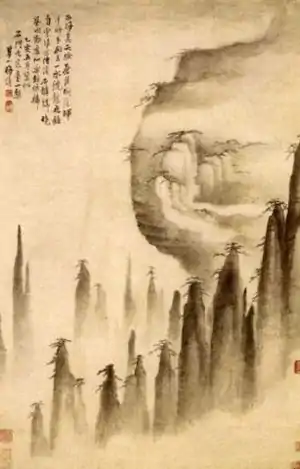
Tiandu Peak of Mount Huangshan. Ink on paper. Palace Museum, Beijing.
Mei Qing (Chinese: 梅清; pinyin: Méi Qīng; Wade–Giles: Mei Ch'ing; ca. 1623–1697) was a Chinese landscape painter, calligrapher and poet active during the Qing Dynasty.

Two Immortals on Huangshan
Mei was born in Xuancheng, Anhui Province.[1] His style name was 'Yuangong' (渊公 or 远公) and his pseudonyms were 'Mount Qu' (Qushan 瞿山), 'Winter Hut' (Xue Lu 雪庐), and 'Lao Qu Fan Fu' (老瞿凡父).[2] Mei was taught by Wang Meng.[1] He was a friend Shitao, influencing some of Shitao's earlier works.[3] His landscape paintings were based on his many travels to the Yellow Mountain.
His works on poetry include: Tian Yan Garret Collection (天延阁集) and Mei Shi Anthology (梅氏诗略).[4]
Notes
References
- Barnhart, R. M. et al. (1997). Three thousand years of Chinese painting. New Haven, Yale University Press. ISBN 0-300-07013-6
- Ci hai bian ji wei yuan hui (辞海编辑委员会). Ci hai (辞海). Shanghai: Shanghai ci shu chu ban she (上海辞书出版社), 1979.
This article is issued from Wikipedia. The text is licensed under Creative Commons - Attribution - Sharealike. Additional terms may apply for the media files.